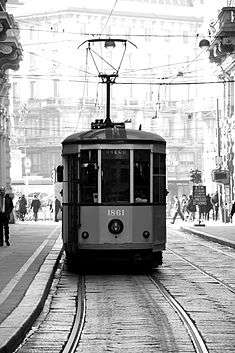Track gauge in Italy
| Track gauge | ||||||||||||||||||||||||||||||||||||||||||||||||||||||||||||||||||||||||||||||||||||||||
|---|---|---|---|---|---|---|---|---|---|---|---|---|---|---|---|---|---|---|---|---|---|---|---|---|---|---|---|---|---|---|---|---|---|---|---|---|---|---|---|---|---|---|---|---|---|---|---|---|---|---|---|---|---|---|---|---|---|---|---|---|---|---|---|---|---|---|---|---|---|---|---|---|---|---|---|---|---|---|---|---|---|---|---|---|---|---|---|---|
| By transport mode | ||||||||||||||||||||||||||||||||||||||||||||||||||||||||||||||||||||||||||||||||||||||||
|
Tram · Rapid transit Miniature · Scale model |
||||||||||||||||||||||||||||||||||||||||||||||||||||||||||||||||||||||||||||||||||||||||
| By size (list) | ||||||||||||||||||||||||||||||||||||||||||||||||||||||||||||||||||||||||||||||||||||||||
|
||||||||||||||||||||||||||||||||||||||||||||||||||||||||||||||||||||||||||||||||||||||||
| Change of gauge | ||||||||||||||||||||||||||||||||||||||||||||||||||||||||||||||||||||||||||||||||||||||||
|
Break-of-gauge · Dual gauge · Conversion (list) · Bogie exchange · Variable gauge |
||||||||||||||||||||||||||||||||||||||||||||||||||||||||||||||||||||||||||||||||||||||||
| By location | ||||||||||||||||||||||||||||||||||||||||||||||||||||||||||||||||||||||||||||||||||||||||
|
North America · South America · Europe · Australia  |
||||||||||||||||||||||||||||||||||||||||||||||||||||||||||||||||||||||||||||||||||||||||
Historically, Italy had two unusual dominant track gauges which were legally defined depending on the terrain encountered. The gauge of 1,445 mm (4 ft 8 7⁄8 in) was used for the national Italian rail network and was very similar to the popular 1,435 mm (4 ft 8 1⁄2 in) standard gauge.
Since the 1930s, the 1,435 mm gauge was adopted and gradually replaced the 1,445 mm track gauge. A few isolated 1,445 mm gauge networks survive to this day.
The other popular gauge, a narrow gauge, was defined at 950 mm (3 ft 1 3⁄8 in) and is very similar to 1,000 mm (3 ft 3 3⁄8 in) commonly used in scenes in Europe or metre gauge and was thus called "Italian metre gauge".
Historical legal definitions of 1879

Italian law defined its track gauges from the centres of each rail,[1] rather than the inside edges of the rails, giving some unusual measurements. According to the law of 28 July 1879, the only legal gauges in Italy were 1,500 mm (4 ft 11 1⁄16 in), 1,000 mm (3 ft 3 3⁄8 in) and measured to the middle of the rail, which corresponds to 1,445 mm (4 ft 8 7⁄8 in) and 950 mm (3 ft 1 3⁄8 in) inside the rail.
The middle size has 1,000 mm between the centres of the rails, which explains why it is called Italian metre gauge, in spite of it in fact being 950 mm in gauge when measured from the inside of the rails in the way gauges usually are measured in other countries.
A disadvantage of measuring from the centre of the rail is that the width of the rail varies, affecting the gauge. It is easier and more reliable to measure from the inner edges of the rails.
1,445 mm (4 ft 8 7⁄8 in) gauge railways
The following 1,445 mm (4 ft 8 7⁄8 in) systems survive today:
- Orvieto Funicular
- Milan tram network
- Turin tram network
- Rome tram network
1,435 mm (4 ft 8 1⁄2 in) or standard gauge railways
The Italian standard gauge railway system has a total length[2] of 24,227 km (15,054 mi) of which active lines are 16,723 km.[3] The network is recently growing with the construction of the new high-speed rail network.
Italian narrow gauge railways
In Italy, track gauges of 1,100 mm (3 ft 7 5⁄16 in), 1,000 mm (3 ft 3 3⁄8 in), 950 mm (3 ft 1 3⁄8 in), 850 mm (2 ft 9 15⁄32 in), 760 mm (2 ft 5 15⁄16 in) and 600 mm (1 ft 11 5⁄8 in) are or were present.
The forementioned 950 mm "Italian metre gauge" was also used in the former Italian colonies Eritrea (Eritrean Railway), Libya (Italian Libya Railways) and Somalia (Mogadishu-Villabruzzi Railway).
See also
References
- ↑ "Parovoz". Archived from the original on 13 July 2012.
- ↑ Total length of tracks: double tracks are counted twice.
- ↑ "La rete oggi". RFI Rete Ferroviaria Italiana. Archived from the original on 4 December 2011. Retrieved 15 November 2011.
